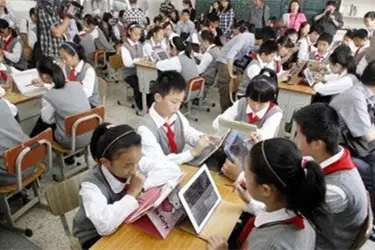In a classroom of the elementary school affiliated to the Renmin University of China, 11-year old Yao Bohan swings from left to right before a computer screen, occasionally shouting. The character on the screen follows his movements and jumps high to eat a fruit every time he shouts.
This is a motion sensing game and Yao is the designer.
Using what he learned in the school's information technology course, Yao made the game with S4A software, Arduino microcontrollers, infrared sensors and sound sensors.
Although the low-cost game cannot compare with sophisticated branded motion-control devices, Yao still has a sense of achievement.
The 40-square-meter classroom is filled with creativity: art works made from copper foil tape, LEDs and button batteries; a robotic car that can be controlled remotely through Bluetooth.
Yao's teacher Zhao Yu employs project-based learning to encourage his students to make their own open-ended creations, based on their personal interests. He was amazed at their wild imaginations and unrestrained creativity.
"In the information technology course, we used to focus on software knowledge that is solely used on computers, but now we often combine hardware and relate it to daily life. When programming is used for real-world projects, it's not boring for primary school students," Zhao says.
He and his students showcased their DIY-products at a booth at the Maker Faire Beijing in August, becoming part of China's dynamic maker movement.
The maker movement - a term for grassroots creativity - is viewed as an engine for China's future economic growth. China is pursuing an innovation-driven development strategy and embracing the maker movement's potential for entrepreneurship and innovation.
Zhao thinks the movement has inspired in teachers the desire to bring the maker spirit into the education system.
In recent years, pioneering schools in cities like Beijing, Shenzhen, Wenzhou and Ningbo have explored ways to bring the maker spirit into schools by launching experimental programs that emphasize making, inventing, and creativity. School maker spaces, maker carnivals and student innovation contests are also popular.
Children learn to make moon cake in extra activities. Xinhua/Zhang Duan
The Ministry of Education released guidelines in 2015 on exploring maker education to equip students with information technology awareness and innovation ability.
Li Yifei, deputy director of the Science Communication and Education Research Center at Beijing Normal University, said that for years, Chinese students were subject to rote learning and test-oriented education that suppressed their natural tendencies to innovate, experiment and create.
"The growing popularity of maker education shows that some schools and teachers have recognized the importance of protecting creativity. The introduction of maker education might be a breakthrough for China's education reform," Li says.
But promoting maker education is no easy task, he cautions. Most Chinese teachers are accustomed to the established curriculum and direct instruction, so they need to explore how to implement project-based teaching and engaging with students.
Wu Junjie, of Beijing Jingshan School, was one of the first Chinese teachers to bring maker education into school. The widespread use of open-source hardware and high-tech tools such as 3D printers offers technology support to maker education, he says.
He and other information technology teachers have watched recent developments and updated their courses. In 2015, they introduced a course on S4A software, and this year, 3D printing.
"The ultimate goal of these courses is to equip students with advanced technology tools to make their own unique creations. Learning is supposed to happen as part of the student's experience as they tackle hands-on projects," Wu says.
Zhu Zhongwen, one of Wu's students, shows great potential. He began to write software when he was 9 and touched on intelligent hardware when he was 12. When he was 14, he became the youngest contestant in China's Hackathon and put forward a concept product called "Dream Swimmer" that can control the dreaming process.
"I believe Chinese students are no less creative than students in other countries. With maker education, I hope more creative minds like Zhu will emerge and continue to develop," says Wu.
Citizens are seen in Jilin Province Library. Photo: Xinhua/Xu Chang
Family and social environments are also vital to nourish the maker spirit, he adds. "In the West, the garage culture and the DIY philosophy are the foundation for maker education. I hope more Chinese families will also add maker culture to home life."
Jia Sifei attends an international school in Beijing and Elon Musk, a typical incarnation of the maker spirit, is his idol.
According to Jia's mother, he has been obsessed with making things with all kinds of materials since the age of 3. When he was 6, he developed a strong interest in open-ended tools such as Arduino microcontrollers and began to build his own interactive hardware.
"I'm happy to see him fully absorbed in the hardware like an engineer and making something he is really proud of," she says. "I think children's passion to create needs to be protected and encouraged."
The Young Maker Institution is an extracurricular training agency that focuses on maker education and provides project-based teaching for students aged 9 to 14. Co-founder Ma Qingyang thinks there is a growing market for maker education in China.
"Although China is to some extent an exam-oriented country, the Gaokao (National College Entrance Exam) is no longer the only path to success," Ma says. "The popularity of overseas study and the emergence of start-ups offer more possibilities to China's youth. Students and parents are starting to pay more attention to independent thinking and creativity, which counts for a lot in their future development."
(APD)
 简体中文
简体中文



